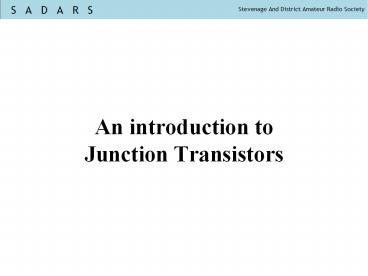An introduction to Junction Transistors - PowerPoint PPT Presentation
1 / 37
Title:
An introduction to Junction Transistors
Description:
... input impedance (due to low current gain) High output impedance (Base ... High voltage gain (if input impedance matched) Works with a low gain transistor (beta) ... – PowerPoint PPT presentation
Number of Views:87
Avg rating:3.0/5.0
Title: An introduction to Junction Transistors
1
An introduction toJunction Transistors
2
BITX20 bidirectional SSB transceiver
3
A BITX20 single stage
4
A simplified single stage
5
A potential divider
6
An NPN Transistor
Collector
Base
Emitter
7
The transfer resistor (transistor)
Emitter (-)
Collector ()
Electrons
Base
Electrons are negative ?
(Original patent used point contact)
8
A silicon atom (Si)
Has 4 outer electrons The outer electron shell
needs 8 to be full (standing wave
pattern) Silicon will try to lend or borrow 4
9
Silicon (group 4) bonds
10
A pure silicon crystal lattice
11
An Arsenic atom (As)
Has 5 outer electrons One surplus for fitting in
to the lattice
12
Arsenic doping (group 5) N type
13
A Gallium atom (Ga)
Has 3 outer electrons One short for fitting in to
the lattice
14
Gallium doping (group 3) P type
Holes are positive
15
A P-N Junction (N on left)
16
What causes the depletion?
- Electrons move from left to right to fill the
holes - Where electrons and holes combine the area is
depleted of current carriers - This leaves the left (N Type) positive so
eventually this prevents the depletion spreading
any more. - Applying negative to N type replaces the depleted
carriers and the current resumes (Forward biased
diode) - Applying positive to the N type removes more
electrons and increases the depletion. Almost no
current flows. (Reverse biased diode)
17
Diode junction (BC107 base-emitter)
18
The transfer resistor (transistor)
Emitter (-)
Collector ()
Electrons
Base
Electrons are negative ?
(Original patent used point contact)
19
An alloy NPN Transistor (powered up)
Depletion
Emitter (-)
Collector ()
Base
Most alloy transistors (e.g. OC71) were germanium
PNP
20
Characteristics of transistors
- Geometry
- Carrier movement
- Collector collection efficiency (Alpha)
- Asymmetry Efficiency / Breakdown voltages
- NPN transistors are normally better than PNP
since electron mobility is better than hole
mobility
21
Current gain of transistors
For the original common base circuit the ratio
of collected current to emitted current was
measured. This is called Alpha. Values have
improved to well over 0.99 (always less than
1). However normally we quote the current gain,
called Beta. Beta Collector current / Base
current Beta values of over 200 are common.
22
NPN Transistor circuits
- Common base
- Emitter follower (common collector)
- Common emitter
Collector
Base
Emitter
23
The first transistor circuit Common base
Base
24
Common Emitter
25
Diode junction (BC107 base-emitter)
26
Emitter follower
27
Our original circuit
- Potential divider bias to linear region
- Partly an Emitter follower
- Partly common Emitter
- Voltage gain set by Collector / Emitter resistor
ratios - More in a later talk
Collector
Base
Emitter
28
Questions?(Summary follows)
29
Common Emitter
30
Features of Common Emitter
- High voltage gain
- High current gain
- Medium input impedance due to high current gain
- High output impedance. For HF capacitive loading
will need to be resonated reducing bandwidth. - Bad HF bandwidth as falling beta with frequency
reduces gain.
31
Emitter follower
32
Features of Emitter followers
- Voltage gain of almost exactly 1
- High current gain
- High input impedance (due to high current gain)
- Low output impedance (Good for unknown loads)
- Good HF bandwidth as falling beta with
frequency matters less.
33
Common base
34
Features of Common Base
- Current gain of approximately 1 (alpha)
- Low input impedance (due to low current gain)
- High output impedance (Base screens collector)
- High voltage gain (if input impedance matched)
- Works with a low gain transistor (beta)
- Good HF bandwidth as falling beta with
frequency matters less.
35
Appendix
36
A Planar NPN Transistor
Collector
Base
Emitter
37
A Planar PNP Transistor on an N substrate
Collector
Base
Emitter































